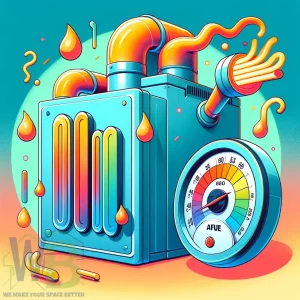What is Delta T in HVAC? Delta T is the difference between the temperature of the air returning to your HVAC system (return air temperature) and the air it sends back into your home (supply air temperature).
This measurement is key to assessing how well your HVAC system is functioning.

Quick Summary
| Section | Key Points |
|---|---|
| What is Delta T in HVAC? | – Delta T is the temperature difference between return and supply air. |
| – Ideal for assessing HVAC system performance. | |
| Return Air vs Supply Air Temp | – Return Air: Air entering the HVAC system. |
| – Supply Air: Air exiting the HVAC system after temperature adjustment. | |
| – Both temperatures are crucial for system efficiency. | |
| Delta T Diagnosis Explained | – High Delta T can indicate airflow problems. |
| – Low Delta T can suggest system inefficiency. | |
| – Used for early detection of HVAC issues. | |
| Delta T Limits | – Ideal Delta T range is typically 15-20°F. |
| – Varies based on system type and design. | |
| – Staying within limits ensures efficiency and comfort. | |
| Importance of Monitoring Delta T | – Regular monitoring helps maintain system health. |
| – Helps detect issues early, ensuring efficient operation and comfort. | |
| – Part of routine HVAC maintenance. | |
| Conclusion | – Delta T is crucial for HVAC health and efficiency. |
| – Contributes to energy savings, comfort, and system longevity. |
What is Delta T in HVAC?
Delta T in HVAC is a term used by professionals to understand how a heating or cooling system is working. The temperature of the air coming in is not the same as the air going out – this temperature difference is what we call Delta T.
The Calculation of Delta T
Calculating Delta T is easy. First, find the temperature of the air going into the system. This is the return air temperature. Then, find the temperature of the air coming out of the system. This is the supply air temperature. Subtract the first temperature from the second one.
For instance, if the return air temperature is 75°F and the supply air temperature is 55°F, the Delta T would be 20°F (75 – 55 = 20).
Why Delta T Matters
Why is this important? Delta T helps us understand how well our HVAC system is working. If the difference is too high, it might mean that the airflow is not as good as it should be.
If the difference is too low, it could indicate that the system is not performing efficiently or cannot handle the space.
In simple terms, Delta T helps us ensure our HVAC system is healthy and working, especially in air conditioning mode.
Return Air Temperature vs Supply Air Temperature
Let’s break down the main differences between Return Air Temperature and Supply Air Temperature:
- Return Air Temperature: It’s the temperature of the air that gets sucked back into the HVAC system after it has already traveled around your home or building.
- Supply Air Temperature: After the HVAC system works on the return air, changing its temperature, it sends it back into your home or building. Now, with a new temperature, this air is called the Supply Air Temperature. It’s ready to go out and do its job of making rooms comfortable.
Why Both Are Important
Knowing why return and supply air temperatures matter is vital for keeping your HVAC system working well.
- High Difference Indicates Strain: If the air going into the HVAC system and the air coming out have very different temperatures, the system works too hard. This can make it get worn out or break sooner. It’s like a machine running at its top speed all the time, which can wear it out faster.
- Low Difference Suggests Inefficiency: A small temperature difference could indicate a problem. It might mean your heating or cooling system isn’t working well. This can lead to discomfort and higher energy costs. The system isn’t doing its main job properly.
- Balance for Optimal Performance: The best situation is when your HVAC system has a balanced Delta T, which works well. This balance ensures the system doesn’t work too hard but keeps your home at the right temperature. Keeping this balance is important to ensure your HVAC system works well for a long time.
Keeping an eye on how warm or cool the air comes in and goes out helps the HVAC system work well, keeps your home comfy, and saves energy.
Delta T Diagnosis Explained
Delta T is like a check-up for your HVAC system. As a doctor checks your heartbeat and temperature to learn about your health, we can check Delta T to understand your HVAC system. If Delta T isn’t right, it could mean a problem.
- High Delta T: Imagine your HVAC system is a runner trying too hard and getting exhausted. A high Delta T means the difference between the return and supply air temperatures is greater than normal. This could mean that the air is not flowing freely through your system. Maybe the air filters are clogged, or there’s a blockage somewhere. It’s like the runner is facing hurdles on the track.
- Low Delta T: On the other hand, a low Delta T, where there’s not much difference between the two temperatures, can be like a runner who isn’t trying hard enough. This might happen if your system loses its power to heat or cool the air effectively. It could be due to several reasons, like low refrigerant levels or system components issues.
Making the Diagnosis
HVAC professionals use special tools to measure the temperatures (Delta T Hygrometer) to diagnose Delta T issues. They check the return air temperature and then the supply air temperature. By subtracting these numbers, they get the Delta T.
They then compare this number to what is expected for your specific system. Each HVAC system has its own “normal” range for Delta T, much like each person has an average heart rate range.
Taking Action
The HVAC professional will investigate if the Delta T is not in the ideal range. They’ll check air filters, ducts, and the system’s overall condition. If they find a problem, they’ll fix it, ensuring the Delta T returns to its ideal range. It’s like helping the runner get back in shape for the race.
Knowing Delta T is important. It helps find issues early and keeps your HVAC system running well; regular check-ups keep you healthy.
Delta T Limits
Delta T limits refer to the ideal range of temperature difference between the return air and supply air in an HVAC system.
This range is crucial because it helps ensure the system operates efficiently and effectively. But what exactly is a good Delta T in HVAC?
- The Ideal Delta T Range: A Delta T of 15 to 20 degrees Fahrenheit is usually good for home HVAC systems. If your return air is 75°F, you should aim for supply air between 55°F and 60°F. Remember that the ideal Delta T may change based on your system’s design and needs.
- Variations Based on System Type: Various HVAC systems may have different ideal temperature differences (Delta T). For example, systems for big buildings might have different Delta T values compared to home systems. It’s crucial to talk to an HVAC expert or check your system’s manual to know the right Delta T for your setup.”
Why Staying Within Limits Matters
Staying within these Delta T limits is important for several reasons:
- Efficiency: Operating within the ideal Delta T range ensures your HVAC system works efficiently. This means it’s not using more energy than necessary, which can save you money on energy bills.
- Comfort: A well-maintained Delta T helps maintain consistent and comfortable indoor temperatures.
- Preventing Wear and Tear: Systems that consistently operate outside their ideal Delta T range may experience more wear and tear, potentially leading to more frequent repairs or a shorter lifespan.
- Early Warning Sign: An out-of-range Delta T can be an early warning sign of issues, such as blocked filters, leaks, or other malfunctions. Addressing these issues promptly can prevent more significant problems down the line.
Understanding and monitoring your HVAC system’s Delta T can be a simple yet effective way to ensure it’s running optimally, providing comfort while keeping energy costs in check.
Importance of Monitoring Delta T
Regularly monitoring the Delta T of your HVAC system is like giving it a routine health check. Just like regular check-ups can keep you healthy, keeping an eye on the Delta T helps maintain your HVAC system’s health. Let’s explore why this is so important.
- Detecting Problems Early: By monitoring the Delta T, you can catch potential issues before they become big problems. For example, if you notice the Delta T is consistently higher or lower than it should be, it might be a sign that something isn’t working right in your system. Catching these issues early can save you from more costly repairs.
- Ensuring Efficient Operation: A well-monitored Delta T helps ensure your HVAC system runs efficiently. An efficient system performs better and consumes less energy, lowering utility bills. Plus, it’s better for the environment.
- Maintaining Comfortable Conditions: By keeping your Delta T within the ideal range, you’re more likely to enjoy consistent and comfortable temperatures in your home. No one likes a room that’s too hot in summer or too cold in winter, and monitoring Delta T can help avoid such discomfort.
How to Monitor Delta T
Monitoring Delta T can be done in a few simple steps:
- Regular Temperature Checks: Use a thermometer to measure the return air temperature and the supply air temperature. Do this every few months to keep track of any significant changes.
- Professional Assessments: During routine HVAC maintenance, ask your service professional to check the Delta T and evaluate the system’s performance.
- Stay Alert to Changes: Pay attention to changes in your home’s comfort level. If you notice rooms not heating or cooling as they used to, it could be a sign of a changing Delta T.
Checking Delta T as part of your home maintenance can make your HVAC system last longer, run well, and keep your home comfortable all year round.
Final Thoughts
Remember, while Delta T is a key indicator of your HVAC system’s performance, it’s just one aspect of overall system health. Regular maintenance is also crucial, including cleaning filters and servicing the system.
If you’re unsure about your Delta T readings or what they mean for your system, contact a professional HVAC technician for guidance and help.
By keeping an eye on Delta T and maintaining your HVAC system, you can enjoy a comfortable, energy-efficient home for years to come.
Check out: The Top AC Unit Brands







